Active Projects
Internet Infra System Tech Research Center (IISTRC)
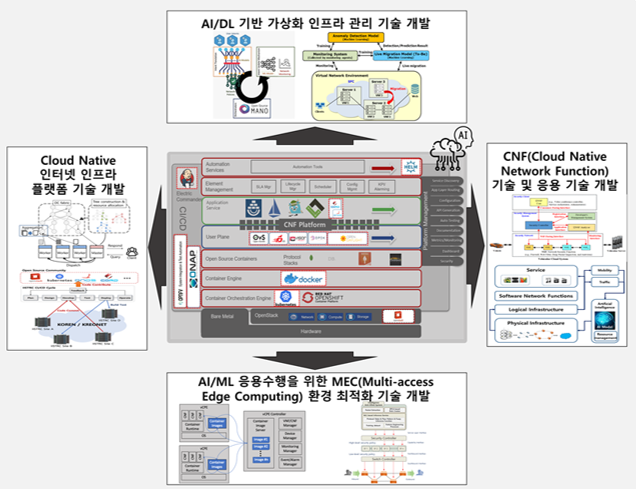
The IISTRC project aims to train professional manpower in opensource-based future infrastructure system technology. This project was started at 2017 and will be ended at 2022. Main project outcomes are including opensource contribution, international standardization and bringing them into proof-of-concepts.
For this project, 6 universities and 4 industries are participating. Also, this project is tightly co-working with domestic research organizations (KANI, SDN/NFV forum, K-IETF) and international organizations (ON.LAB, UC. Davis).
This project is separated into 4 working groups.
- WG1 – Development of cloud-native internet infra technology
- WG2 – Development of AI/DL-based infra management
- WG3 – Development of CNF(Containerized Network Function) and application for future internet infra
- WG4 – Development of MEC(Multi-access Edge Computing) optimization with AI/DL
SW Starlab
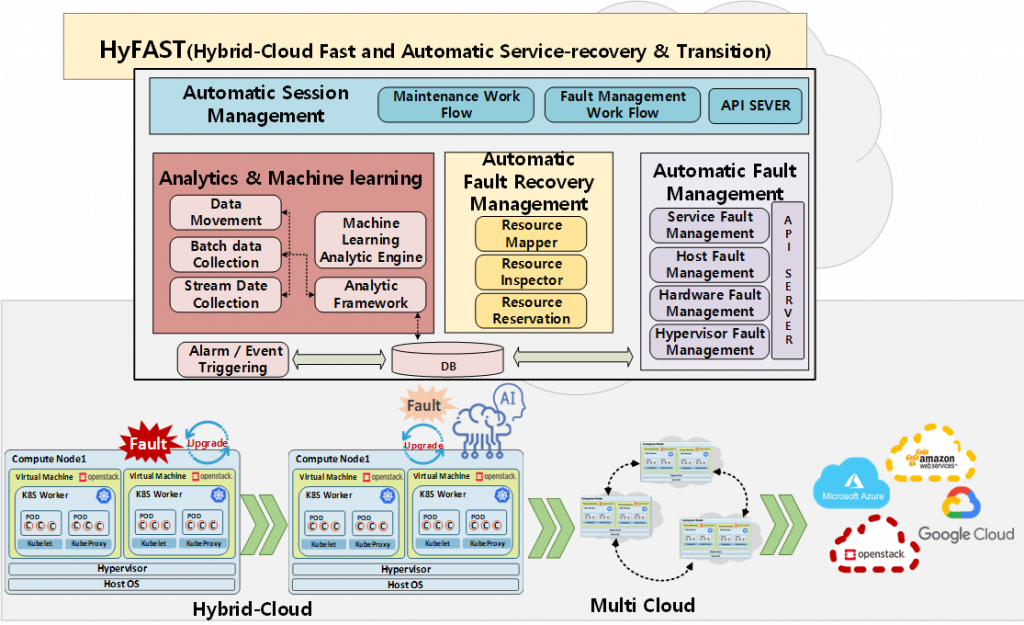
The StarLab project aims to secure university-oriented global source technologies by selecting and supporting excellent laboratories that have accumulated basic and source technologies in each SW field and can conduct practical research. The lab has been selected for the cloud field and will perform “Development of Fast and Automatic Service recovery and Transition software in Hybrid Cloud Environment”. This project was started in 2020 and will be ended in 2027.
For this project, the lab develops HyFAST System on its own. The project is being carried out in three stages, and various management and maintenance features are currently being developed in a hybrid-cloud environment (OpenStack and Kubernetes) where VM and container infrastructure are mixed in the first stage until 2023.
The project is progressed into 3 stages.
- Stage1 – Development of HyFAST in hybrid cloud environment
- Fast and automatic service recovery and transition software based on multilayer monitoring
- Automation workflow and integrated orchestration software
- Situational data (e.g. Event, Log, Multilayered state) management
- ML-based analysis and prediction features
- Stage2 – Development of HyFAST in multi-cloud and heterogeneous cloud environments
- Extending orchestration features to support heterogeneous cloud environments
- Extending orchestration features to support multi-site environments such as distributed edge clouds
- Stage3 – Demonstration and optimization of HyFAST
- Demonstration of HyFAST that applied in private cloud and edge cloud
- Optimization of automation features
Intelligent 6G Mobile Core Networks

The Development of Candidate Element Technology for Intelligent 6G Mobile Core Networks project aims to to study the source element technologies of 6G mobile core networks that support network and computing convergence, hyper-distribution and automation, and AI application orchestration. This project was started in 2022 and will be ended in 2025.
- Development of Candidate Architectures for Intelligent 6G Mobile Core Networks
- A Study on the Applicability of New Protocols
- A Study on Automation Technology for Distributed Intelligence Environment of 6G Network
Closed Projects
K-ONE (Korea – Open Networking Everywhere)
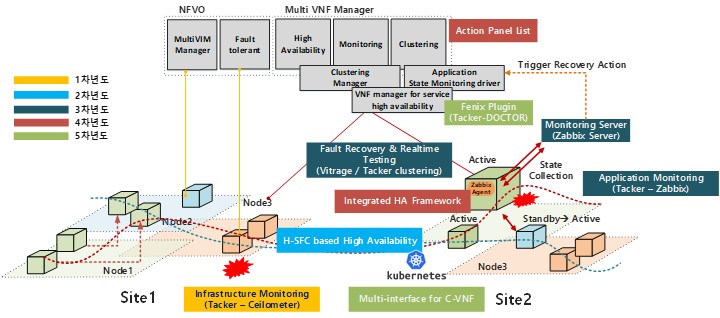
This project aimed to develop opensource-based SDN/NFV/Cloud software and integrate them as a uniform platform. In this project, we focused to develop high availability functionalities in OpenStack-based NFV infrastructure. Main achievements were 7 code contributions to the OpenStack Tacker project and they are available in OpenStack main releases as below;
- Alarm-based monitoring in Tacker
- Auto-scaling policy in heat-translator in Selin
- Zabbix plugin for application monitoring in Tacker
- Tacker client for supporting VNF cluster
- Multi-interface for containerized VNF in Tacker
- Fenix plugin for rolling updates in Tacker
ICN-DTN Networking System in MEC Environment
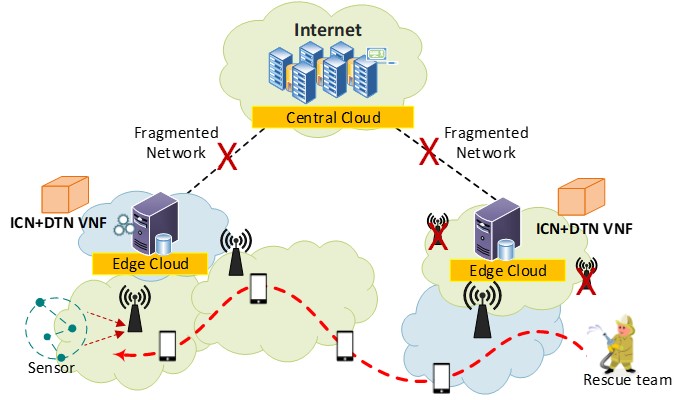
This project aimed to implement MEC platform to support VNF with ICN (Information Centric Networking) and DTN (Delay Tolerant Networking) functionalities. In this project, the main use-case was disaster scenario that link between core and edge was disconnected. For exchanging emergency data between central office and remote rescue team, ICN-DTN based VNF running in mobile edge can forward data even the link is not stable for a while. Main achievements of this project were including design of basic message delivery procedure based on disaster information delivery system tailored to the domestic environment and development edge features based on opensource NFV platform.
vEPC (Virtualized Evolved Packet Core)
Testbed Implementation
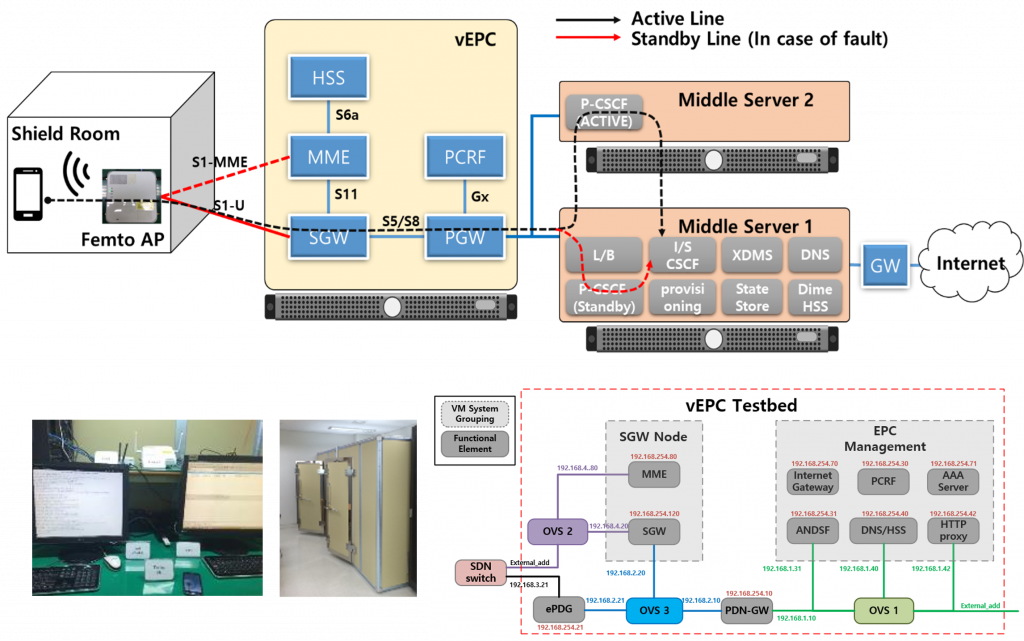
This project aimed to implement mobile packet core functionalities on the NFV platform and to provide them for verifying industrial developing applications. For that, we implemented 4G EPC (Evolved Packet Core) and IMS (Internet Multimedia System) system in the OpenStack-based infrastructure. To support radio access network (LTE, WiFi), we used commercial femto cells and WiFi AP. All radio access test can be done in the shield room. Using the testbed, it is available to verifying mobile application with 3GPP standard connection setup and mobility scenario. Also, it is possible to verify new VNFs which are required to interwork with 3GPP mobile core components.
